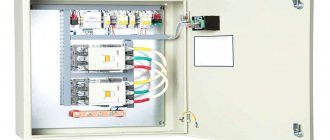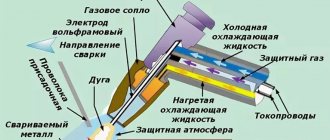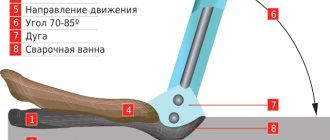Modern electrical appliances are designed to be as user-friendly as possible, and in order to use them it is not at all necessary to know what current is in the socket where they are connected. Such knowledge may never be useful in everyday life - usually it is enough to know that there is current in the outlet, thanks to which all household appliances work.
How can you measure AC voltage?
You can change the variable network voltage, like any other electrical characteristics of the network, using special measuring instruments: voltmeters, ammeters, ohmmeters. Modern testers and multimeters contain the functions of all of them, so it is better to use them. In order to measure a parameter, follow the instructions:
Find the measurement scale on the device, which is most often located on the right. Set the measurement limit, knowing that, for example, there is approximately 220 volts in the outlet. Take the probes and insert them into the source
It does not matter which probe is inserted where. Make measurements taking into account safety precautions. Record the obtained indicators.
Thus, there is a difference between direct voltage and alternating voltage, and it is significant. Based on constant and intermittent current forces, generators have been manufactured that convert mechanical energy into electrical current of various types, which can be supplied faster and further through wires.
Excursion into history
So, the generator at our power plant converts mechanical energy into electrical energy. What's next? In what form and how exactly to transfer energy to the consumer? How to avoid colossal transmission losses?
Amazingly, such a situation actually existed! In the Russian Empire, until the beginning of the 20th century, there was complete confusion. A separate power plant was built next to each “large” consumer of electricity (a factory, the farmstead of a successful merchant, or a hotel for people of noble blood). There were many competing companies providing electrification services and, subsequently, their own electrical equipment tailored only for their network. Each electricity supplier set its own power grid parameters - voltage, frequency. There were even DC power grids! A person who bought, for example, light bulbs from the Lodygin and Co. Electric Lighting Partnership could only use them in the electrical network of the same company. If connected to the General Electric network, this light bulb would immediately fail - the network voltage of this company was significantly higher than necessary, not to mention other parameters.
Only in 1913 did imperial engineers decide to transmit electricity over long distances via overhead wire lines, eliminating the need to build power plants “at every outlet.” On the eve of the coming great war and the surge of patriotism, the authorities began to think about import substitution. Well, just like in our time, after the 2014 crisis). Many small Western firms (except German and French) were financially and legally suppressed; preferences and benefits were given only to domestic partnerships and enterprises. As a result, this led to monopoly in the electricity supplier market and, unwittingly, standardization of electrical network parameters.
Since Berlin and Paris were already electrified by a single power grid with 220 volt alternating voltage, domestic companies also adopted this standard. It was more convenient for people to use electrical appliances of a single type, without worrying that their newfangled electric vacuum cleaner would burn out at a new place of residence due to other parameters of the power grid. There was a complete displacement of many small firms - no one wanted to use their services and their devices, although they were forced to adapt to a single standard of the electrical network. Those same 220 volts AC.
Current transmission
AC power sources are regular outlets.
They are located at facilities for various purposes and in residential premises. Various electrical devices are connected to them, which receive the voltage necessary for their operation. The use of alternating current in electrical networks is economically justified, since the magnitude of its voltage can be converted
to the level of required values. This is accomplished using transformer equipment with minor losses allowed. Transportation from power sources to end consumers is cheaper and easier.
The transfer of current to consumers begins directly at the power plant, where a variety of extremely powerful electrical generators are used. Electric current is obtained from them, which is sent through cables to transformer substations. Often, substations are located near industrial or residential electrical consumption facilities. The current received by the substations is converted into three-phase alternating voltage.
Batteries and accumulators contain direct current
, which is characterized by stable properties, i.e. they do not change over time. It is used in any modern electrical products, as well as in cars.
What is alternating current: definition
Everyone has heard this term, but not everyone knows what it means. Variable is the chaotic movement of charged particles, changing its polarity from plus to minus with a certain frequency, which is measured in hertz (Hz). If you draw a graph, then such a value will look like a sinusoid periodically crossing the “X” coordinate axis. If we talk about three-phase current, then it flows not through one conductor, but through three. The phase sinusoids are ideally completely identical, but shifted relative to each other by 120 degrees.
Alternating current is found everywhere. It is produced at power plants by generators with various drives. Such current is easy to transmit over various distances and it is quite easy to obtain a constant current from it, which cannot be said about the reverse transformation. For “transportation” with minimal losses, the voltage is increased to 25 kV, as a result of which, according to the laws of physics, the current strength, measured in amperes (A), is reduced. When it reaches the desired point, it goes to the primary transformer substation. The voltage on it is reduced to 6 kV and sent further. The last transformer further reduces the voltage to the usual 0.4 kV (400V). It is this current that enters apartment buildings in three phases. Here the phases are evenly distributed, as a result of which 1 phase is supplied to each dwelling, capable of providing the premises with an electrical voltage of 220 V.
So what is the current in the outlet? Of course it is variable. Almost all household appliances work on it. If the device requires direct current, special transformers with rectifiers (diode bridges), called adapters, are used. Televisions, computers, and stereo systems are often equipped with similar power supplies.
What is the current in 220V and more
The value of the passing electricity from the outlet is determined in Amperes, while the output voltage is 220 V. It turns out that the current strength is a physical quantity equal to the ratio of the charge that passes through the conductor in a certain time. If there is no connection to the outlet, then the electrical circuit is considered broken.
Electrical equipment
When the wiring is not protected automatically, the power is under control, so the Ampere value in the outlet is different at a voltage of 220V. The power indicator in this case constantly increases until the electrical equipment fails.
Professionals advise choosing sockets with 16 amperes or more, as they are more reliable; the wiring is made from a 2.5 mm2 cable. When choosing an outlet rated for fewer Amperes, the protection may not work, which often leads to accidents on the line.
Voltage formula
There is a formula in physics, although it has no practical application. The official formula is written like this.
voltage formula
Where
A is the work done by the electric field to move a charge along a section of the circuit, Joules
q - charge, Coulomb
U—voltage on a section of the electrical circuit, Volts
In practice, the voltage across a section of a circuit is derived through Ohm's law.
It will be interesting➡Features of current resonance
voltage from Ohm's law
Where
I - current, Amperes
R - resistance, Ohms
Types of device
A multimeter (multitester) is a device for measuring a variety of parameters of the electrical network, as well as other elements powered from it.
The device allows you to accurately determine network characteristics such as voltage, current, resistance and a number of other data. The multitester also makes it possible to test transistors, test cables and wires, test diodes, etc.
From the point of view of the design of the device itself, analogue and digital multimeters are distinguished. The devices differ in functional characteristics, accuracy of operation, workmanship, and configuration.
Analog testers are often called voltmeters or ammeters, since such devices are usually configured to perform 2-3 functions and nothing more. Analog devices show measurement results with a regular arrow on a scale. This technique is quite difficult to operate and requires some experience. A beginner will not immediately understand all the available scales in order to determine the final value of electrical data. In addition, analog equipment is not able to fix the arrow in position, which makes it difficult to work with.
The digital device displays measurement results in electronic form (on a liquid crystal monitor). The device is easy to operate and dramatically reduces the participation of the human factor, and therefore errors in measurements. The simplicity and accuracy of readings have made digital devices the most popular on the market.
Advantages of DC
- The main advantage of DC electrical energy is the absence of reactive power. This means that all the power generated by the generator is consumed by the load minus losses in the wires.
- Direct current, unlike alternating current, flows throughout the entire cross-section of the conductor.
These two points lead to the fact that if the same power is transmitted at equal voltages with direct and alternating currents, then the power losses of electricity with direct current would be almost half as much as with alternating current.
In addition, if we consider such consumer electronic devices as laptops, computers, televisions, etc., then they all have power supplies that convert alternating voltage 220 V (230 V) into a direct voltage of a lower value. And such transformations are associated with a partial loss of power.
In addition, as mentioned earlier, a three-phase asynchronous motor (IM) can be connected directly to a 380 V network, which is quite justified in the case when it is not necessary to change the operating mode of the motor. But if it is necessary to change the rotation frequency of its shaft, then it is necessary to apply voltage to the stator windings, the frequency and amplitude of which must change proportionally, according to Kostenko’s law. For this, three-phase autonomous inverters (AI) are used, most often voltage inverters. Such inverters must be powered from a constant voltage source.
It should also be noted that recently solar batteries that generate direct current have begun to be used very widely. In addition, the power of rechargeable batteries has increased significantly and the capacity of supercapacitors, which also belong to direct current sources and are finding more and more practical applications every day, has increased.
Features of home and office electrical wiring
The “last mile” of the power supply system begins after the last transformer substation, which reduces the voltage to 0.4 kV. The primary windings of the last step-down three-phase transformer can be connected in any circuit (“triangle” or “star” - as convenient for power engineers), but the secondary windings are usually always connected in a “star” circuit. Moreover, the connection point of the transformer windings is electrically connected to the ground, and an additional wire, called “zero”, goes to this point. Thus, electrical energy from the step-down transformer substation is supplied to consumers through four wires, three of which are “phase” (phase A, phase B and phase C), and the fourth is zero (Figure 12).
| Figure 12. | Voltages in a three-phase network. |
The voltage of each of the secondary windings of the transformer is 230 V. Thus, the voltage between the neutral and any of the phase wires is 230 V. This power engineering voltage is called “phase”. But if you measure the voltage between any two phase conductors, it turns out that it will be approximately equal to 400 V, which is almost twice as much. This voltage is called "linear". The exact correspondence between phase VF and linear VL voltages is determined by the formula:
| (11) |
This happens due to the fact that the phase voltages are out of phase by 120°, which is why this increase occurs (Figure 13). In this case, the resulting voltage is sinusoidal, but shifted in phase by –5π/6 (–150°) with respect to the reference phase (the phase whose potential is taken as zero during measurements).
| Figure 13. | The principle of the formation of linear voltages. |
The ability to obtain multiple voltages is another advantage of a three-phase system, because, as we know from the previous article, the higher the supply voltage, the less current in the circuit and the cheaper the electrical cables. Thus, low-power consumers, theoretically, can be connected to a phase voltage of 230 V, and high-power ones to a linear voltage of 400 V, which will allow 1.732 times more energy to pass through the same cable.
However, in practice they do things a little differently. Low-power consumers are, indeed, connected to one of the phases of the power supply system, and high-power consumers are connected to three phases at once (Figure 14). In this case, powerful consumers consume energy from three phases at once, which ensures uniform distribution of the mechanical load on the power plant generator shaft and reduces losses during the transportation of electricity.
| Figure 14. | Methods for connecting consumers of different power. |
In power supply systems, consumers with a power of more than 1 kW are considered “powerful”. From this level, three-core copper cables become cheaper than two-core ones. Because of this, it is very difficult to find single-phase equipment with a power of more than 2.5 kW. For the same reason, the maximum current of most electrical outlets does not exceed 16 A. At this current, the maximum power that can be consumed from the outlet is 230∙16 ≈ 3.7 kW, which is quite enough to power most single-phase appliances.
Practical significance of the differences
This is what it is, alternating and direct current. It's not that difficult to figure out what the difference is. There is a difference and a very big one. A DC source will not allow you to connect a welding, or any other, transformer. When calculating insulation or capacitors, the maximum voltage value, rather than the effective voltage, is taken for breakdown. After all, the thought may certainly arise: “why do you need 400-volt capacitors in a 220-volt network?” Here is the answer, in a 220 V network the voltage reaches 380 V during normal operation, and in the event of a minor failure, 400 V is not the limit.
People have long been accustomed to the benefits of electricity and many do not care what current is in the outlet. On the planet, 98% of electricity generated is alternating current. It is much easier to produce and transmit over significant distances than constant. In this case, the voltage can change many times in value down and up. The current strength significantly affects the losses in the wires.
Transmission of electricity over a distance
The parameters of the home network are always known: alternating current, voltage 220 volts and frequency 50 hertz.
They are mainly suitable for electric motors, refrigerators and vacuum cleaners, as well as incandescent lamps and many other devices. Many consumers operate at a constant voltage of 6-12 volts. This especially applies to electronics. But the power supply of the devices must be of the same type. Therefore, for all consumers, the current in the outlet must be variable, with the same voltage and frequency.
What are phase and zero
220 Volt comes to you through two wires. Sometimes there is also a third yellow-green wire in conjunction with them - this is the ground. This wire is used for safety purposes. Old houses do not have such a wire. The ground in 90% of cases is designated as a yellow-green wire. Other wires may have different colors, but most often they try to mark the zero with a blue wire, and the phase with a bright color. For example, red.
Designation of phase, zero and ground on the wire
So, phase zero flows through the other . Zero is a wire for removing electric current from a phase. Zero does not pose a danger to humans, but it is still better not to experiment! In phase, the voltage changes very quickly, first from some maximum value (for 220 Volts this value is 310 Volts), then drops to zero, and then goes negative and reaches a value of -310 Volts and then again to zero and again to 310 Volt. So, in a second he manages to perform this operation 50 times, since the generator at a hydroelectric power plant, thermal power plant or nuclear power plant rotates at exactly this speed.
oscillogram 220 V
Types of current
There are two types of current - direct and alternating. To understand the difference and determine whether the outlet has direct or alternating current, you should delve into some technical features. Alternating current has the property of changing in direction and magnitude.
Direct current has stable qualities and direction of movement of charged particles.
Alternating current comes out of the power plant generators with a voltage of 220-440 thousand volts. When approaching an apartment building, the current is reduced to 12 thousand volts, and at the transformer station it is converted to 380 volts. The voltage between phases is called linear. The low-voltage section of the step-down substation produces three phases and a zero (neutral) wire. Energy consumers are connected from one of the phases and the neutral wire. Thus, single-phase alternating current with a voltage of 220 volts enters the building.
The distribution diagram of electricity between houses is presented below:
In the home, electricity is supplied to the meter, and then through automatic machines to the boxes of each room. The boxes contain wiring throughout the room for a couple of circuits - electrical outlets and lighting equipment. The machines can be provided one for each room or one for each circuit. Taking into account how many amperes the outlet is designed for, it can be included in a group or connected to a dedicated circuit breaker.
Alternating current accounts for approximately 90% of all electricity consumed.
Such a high specific gravity is due to the peculiarities of this type of current - it can be transported over considerable distances by changing the voltage at substations to the required parameters.
Sources of direct current are most often batteries, galvanic cells, solar panels, thermocouples. Direct current is widely used in local networks of automobile and air transport, in computer electrical circuits, automatic systems, radio and television equipment. Direct current is used in contact networks of railway transport, as well as on ship installations.
The diagram below shows the fundamental differences between direct and alternating currents.
Some tips for choosing RCD and AB sockets
The first step is to write down separately the power of all household appliances, dividing them into groups from which they will be powered. By calculating what current in the outlet will be maximum, you can determine the parameters of the circuit breaker and RCD required for a particular line. If a general residual current device is planned, then all current indicators are added up. This is quite acceptable, but it should be remembered that each group must have a separate circuit breaker. It is installed after the RCD, which is powered by an electricity meter. Here, between the meter and the residual current device, it is necessary to install a common circuit breaker. It will protect the RCD in case of a short circuit or heating of the wiring. Another place for mandatory installation of an automatic or batch switch is in front of the electric meter. It is used when it is necessary to replace or service a metering device.
The need for automatic power off
A circuit breaker is an important element in the electrical supply system of a room. There are special devices on distribution panels that indicate how many amperes of the maximum allowable current. Typically, 16, 25 or 32 ampere circuit breakers are installed for household purposes. It is recommended to install its own circuit breaker for each powerful device. For example, an electric stove has a power of 6 kilowatts or 6000 watts, therefore the current will be 27 amperes at a voltage of 220 volts. In this case, you need a larger circuit breaker, namely 32 amperes.
General definitions
The physical process in which charged particles move in an orderly (directional) manner is called electric current. It is usually divided into variable and constant. For the first, the direction and magnitude remain unchanged, but for the second, these characteristics change according to a certain pattern.
The above definitions are greatly simplified, although they explain the difference between direct and alternating current. To better understand what this difference is, it is necessary to provide a graphical representation of each of them, as well as explain how the alternating electromotive force is generated in the source. To do this, let us turn to electrical engineering, or rather its theoretical foundations.
Where can electrical knowledge come in handy?
It’s good if questions about the operating principles of electrical appliances arise simply out of “sporting interest.” It gets worse when traveling to another country, where unprepared travelers are surprised to find sockets of an unfamiliar type. If before this a person paid attention to the inscriptions near “his” sockets, then in “strangers” there may be a different frequency and voltage. To understand why this happens, you need to at least be familiar with the basics of electrical engineering.
It is immediately necessary to make a reservation that everything described below is given in a very simplified and exaggerated form. Some analogies may not fully reflect all processes occurring in electrical wiring and are given solely for their general understanding.
Types of electric current in everyday life
In order to determine what current is in the outlet, there is no need to study this issue at the university level. There are only two types of voltage - constant and alternating.
The answer to the question of whether the current in an outlet is alternating or direct is clear now, but at the beginning of the twentieth century, two great inventors argued on this topic - Nikola Tesla, who supported the idea of alternating current, and Thomas Edison, who advocated direct current. During this period, the outlet could have either direct or alternating current, depending on the country and the building's power supply.
In the end, Tesla's point of view won, and direct current is now used mainly in electric drives, which are powered from an alternating current network through diode or thyristor rectifiers.
Interesting! Some buildings in San Francisco retained DC-powered elevators in 2012. This equipment and the supply of such voltage to buildings were preserved as a rarity. In New York, such installations operated until 2007.
D.C
The international symbol for this DC voltage is Direct Current (direct current), and the symbol on electrical diagrams is “—” or “=”. The magnitude and polarity of this type of voltage are unchanged, and the current strength changes only when the load changes. This type of electric current is produced by batteries, batteries and elements of solar power plants.
The engines of trams, trolleybuses and other electric vehicles operate from the DC network. These electric motors have better traction characteristics than AC motors.
Information! Most electronic circuits operate on DC voltage, but they are powered by AC power through a built-in or external power supply with a rectifier.
Alternating current
The international designation for this AC voltage is Alternating Current, and the symbol on electrical diagrams is “~” or “≈”.
The magnitude and polarity of alternating current in the network changes all the time. The frequency of these changes is 50Hz in Europe and some other countries and 60Hz in the USA. Most household and industrial electrical appliances are manufactured to be powered by alternating voltage.
Almost all electricity used in everyday life and industry is variable. For transmission over long distances, it is increased using transformers, and at the end point of the line it is reduced to the required value. This allows you to reduce the cost of power lines and losses. In order to eliminate voltage fluctuations, stabilizers are installed for critical devices.
With increasing voltage and constant transmitted power, the current strength and cross-section of the wires decrease proportionally. If the voltage is not increased, then large cross-section cables must be used to supply electricity to the consumer, and transmission over long distances will be impossible. That's why the outlet has AC current.
There are two contacts in a home socket - phase and neutral. In some cases, a grounding cable is added to them. This single-phase voltage is part of a three-phase system. It includes three identical networks. The voltage in these networks is phase shifted by 120° relative to each other.
At first this system was six-wire. Nikola Tesla invented it in this form. Later, M. O. Dolivo-Dobrovolsky improved this scheme and proposed transmitting three-phase voltage over three or four wires (L1, L2, L3, N). He also showed the advantages of a three-phase power supply system over schemes with a different number of phases.
Sockets
So, let's move on to the topic of what current is used in the outlet: direct or alternating. Let's move on to sockets, because they appear in the question. So, are there sockets for constant voltage and alternating voltage? Let's say right away that there is. How are they different from each other?
Let's start with the fact that sockets in which alternating voltage is present are indicated by the symbol (~) or the letters of the Latin alphabet (AC), that is, Alternating Current, which is translated from English as alternating current.
DC outlets are identified by a (–) symbol or the letters DC (Direct Current). In the diagrams, such sockets are indicated by a plus and a minus with an arrow. Let’s immediately make a reservation that it is useless to plug ordinary household appliances into an outlet where there is constant voltage. They still won't work. Pay attention to the figure below, where the icons are indicated.
So, many manufacturers put them on sockets for ease of recognition, that is, what voltage they are intended for. As you can see, even purely visually you can determine what voltage is in the outlet: constant or alternating. Of course, all these are nuances, because domestic networks supply only alternating current, so there is no need to even look at what markings the outlet has, whether there are special symbols or not.
Home electrical network parameters
The main parameters of electricity are its voltage and frequency. The standard voltage for home electrical networks is 220 volts. The generally accepted frequency is 50 hertz. However, in the USA a different frequency value is used - 60 hertz. The frequency parameter is set by the generating equipment and is unchanged.
The voltage in the network of a particular house or apartment may be different from the nominal value (220 volts). This indicator is influenced by the technical condition of the equipment, network loads, and substation load. As a result, the voltage may deviate from the specified parameter in one direction or another by 20–25 volts.
What is electric current
Everyone knows from the school physics curriculum that current is the directed movement of electrons. In all power plants, the principle of generating electricity is the same. To do this, it is necessary that the shaft of the rotor unit rotates. Essentially, it is a bundle of copper that is located between two magnets. You can rotate the shaft using water, wind, hot air (steam) and so on. That is why power plants are divided into types: hydro, wind, thermal, and so on.
Why are magnets needed? With their help, electrons inside the copper begin to move due to the generated magnetic field, forming a directed movement, that is, a current flow. To release electrons, a wire is connected to the copper, which drains the current from the installation.
But why is the current generated by a power plant called alternating? It's all about changing the direction of electron movement. There are indicators such as current frequency and voltage. So in domestic electrical networks, the current frequency is 50 Hz and the voltage is 220 volts. The frequency indicates that in one second the current changes its direction 50 times, and accordingly the charges of the particles from positive to negative. As for voltage, it is essentially the pressure or pressure of electrons in the network.
So, alternating current is a change of charges. Therefore, the voltage changes from maximum to minimum and vice versa 50 times within one second, for a total of 100 times. Either it becomes maximum (100%), then minimum (0%). And this cycle repeats itself all the time. If the voltage in the network was always constant, and at the same time maximum, then wiring it would require an electrical cable of huge cross-section. This is not necessary with variables. A small diameter wire can transmit millions of volts.
Working principle of alternating current
So, answering the question of what current is in the outlet, you need to know why it is alternating and not constant. And yet, why is direct current called that? Firstly, it never changes its direction, does not jump and has no frequency. Secondly, it is present only in batteries and accumulators, as well as in generator sets.
Where does the voltage come from?
To supply electricity to an outlet, it must be generated somehow. To generate electricity, technologies from the late 19th century are still mostly used - electromagnetic induction, which converts mechanical energy into electrical energy. In other words, generators. The difference between generators is only in how mechanical energy is supplied. Previously, these were bulky steam engines. Over time, hydraulic turbines for running water (hydroelectric power stations), internal combustion engines, and nuclear reactors were added.
The operating principle of the generator is based on magnetic induction. The rotational movement of the generator is converted into electric current. That is, we can say that a generator is the same electric motor, but of reverse action. If voltage is applied to the electric motor, it will begin to rotate. The generator works in reverse. The rotational movement of the generator shaft is converted into electric current. Therefore, in order to rotate the generator shaft, we will need some kind of external energy. It could be steam that spins the turbine, which in turn spins the generator shaft
Operating principle of thermal power plants
or it can be the force of the water flow, which, with the help of a hydraulic turbine, spins the generator shaft, and it, in turn, also generates electric current
Operating principle of hydroelectric power station
Well, or it could even be a windmill
Wind power plant
In short, the principle is the same everywhere.
By the way, a nuclear reactor is not capable of generating energy on its own. In fact, a nuclear power plant is the same primitive steam boiler, where the working fluid is ordinary steam. Yes, today there are other ways to generate electricity, such as the same solar cells, beta-galvanic and isotope nuclear batteries, “mythical” tokomaks. However, the above-mentioned “high-tech” has significant limitations - the prohibitive cost of materials, installation and setup, dimensions and low efficiency. Therefore, it is not worth seriously considering all this as a full-fledged high-power power plant (at least in the next couple of decades).
Does the outlet have direct or alternating current?
Types of current.
There are 2 types of current - direct and alternating.
- Direct current - has a certain direction of movement of charged particles.
- Alternating current - has the property of changing in direction and magnitude.
Alternating current comes from power plant generators. At the transformer station it is converted to 380 volts. The low-voltage section of the substation produces three phases and a neutral wire; consumers are connected from one of the phases and the neutral wire. As a result, an alternating single-phase current with a voltage of 220 volts enters the building. Electricity in a residential building is supplied to the meter, and then through automatic machines to distribution boxes in each room. Junction boxes distribute wiring throughout the room for outlets and lighting fixtures.
Direct current is used: in batteries, solar panels, thermocouples, in local networks of automobile and air transport, in computer electrical circuits, automatic systems, television equipment.
Alternating current makes up about 90% of all electricity consumed, this is due to the fact that it can be “transported” over vast distances by changing the voltage to the required parameters.
Home electrical network parameters.
The standard voltage for home electrical networks is 220 volts, frequency is 50 hertz. The frequency parameter is unchanged, but the voltage in the network may differ, it is influenced by: network loads, equipment condition, substation load.
Current load.
All sockets have a permissible current load, which can be determined by markings; for example, the designation “6A” indicates a maximum current of 6 amperes. All electrical appliances have a technical passport, the power consumption is necessarily indicated there. Do not overload sockets; this may result in equipment failure and fire.
Methods for measuring voltage and current.
To measure voltage and current indicators you need:
Voltage indicator - can be:
- single-pole - detects the phase in the socket contact, but does not detect the presence or absence of zero.
- bipolar - shows the current between phases, as well as between zero and phase.
Multimeter - measures any type of current present in the outlet and checks the voltage level.
Methods for measuring voltage and current
To measure voltage and current, the following methods are used:
- The simplest method is to connect an electrical appliance of the appropriate voltage to an outlet. If there is current in the outlet, the appliance will function.
- Voltage indicator. This device can be single-pole and take the form of a special screwdriver. Two-pole indicators with a pair of contactors are also available. A single-pole device detects the phase in the socket contact, but does not detect the presence or absence of a zero. The bipolar indicator shows the current between phases, as well as between zero and phase.
- Multimeter (multitester). Using a special tester, measurements are made of any type of current present in the outlet - both alternating and direct. Also check the voltage level with a multimeter.
- Control lamp. Using a lamp, the presence of electricity in the outlet is determined, provided that the light bulb in the control device corresponds to the voltage in the outlet being tested.
The information listed above is quite sufficient for a general understanding of the principles of organizing the electrical network in the house. You should begin carrying out any electrical work only in compliance with all safety measures and with the appropriate qualifications.
People have long been accustomed to the benefits of electricity and many do not care what current is in the outlet. On the planet, 98% of electricity generated is alternating current. It is much easier to produce and transmit over significant distances than constant. In this case, the voltage can change many times in value down and up. The current strength significantly affects the losses in the wires.
Transmission of electricity over a distance
The parameters of the home network are always known: alternating current, voltage 220 volts and frequency 50 hertz.
They are mainly suitable for electric motors, refrigerators and vacuum cleaners, as well as incandescent lamps and many other devices. Many consumers operate at a constant voltage of 6-12 volts. This especially applies to electronics. But the power supply of the devices must be of the same type. Therefore, for all consumers, the current in the outlet must be variable, with the same voltage and frequency.
What is the difference between AC and DC current
The general concept of electric current can be expressed as the movement of various charged particles (electrons, ions) in a certain direction. And its value can be characterized by the number of charged particles that passed through the conductor in a certain period of time.
If the value of charged particles of 1 coulomb passes through a certain cross-section of a conductor in a time of 1 second, then we can talk about a current strength of 1 ampere flowing through the conductor. This determines the number of amperes or current. This is the general concept of current. Now let's look at the concept of alternating and direct current and their differences.
A direct electric current, by definition, is a current that flows in only one direction and does not change over time. Alternating current is characterized by the fact that it changes its direction and magnitude over time. If direct current is graphically displayed as a straight line, then alternating current flows through the conductor according to the sine law and is graphically displayed as a sine wave.
Graphical representation of DC current
Since alternating current varies according to the law of a sinusoid, it has such parameters as the period of a complete cycle, the time of which is denoted by the letter T. The frequency of alternating current is the inverse of the period of a complete cycle. The frequency of alternating current is expressed by the number of complete periods in a certain period of time (1 sec).
Graphical representation of alternating current
There are 50 such periods in our AC power network, which corresponds to a frequency of 50 Hz. F = 1/T, where the period for 50 Hz is 0.02 sec. F =1/0.02 = 50 Hz. Alternating current is denoted by the English letters AC and the sign “~”. Direct current is designated DC and has a “-” symbol. In addition, alternating current can be single-phase or multiphase. A three-phase network is mainly used.
A Brief History of Electricity
Who invented electricity? And no one! People gradually understood what it was and how to use it.
It all started in the 7th century BC, on one sunny (or maybe rainy, who knows) day. Then the Greek philosopher Thales noticed that if you rub amber on wool, it will attract light objects.
Then there were Alexander the Great, wars, Christianity, the fall of the Roman Empire, wars, the fall of Byzantium, wars, the Middle Ages, the Crusades, epidemics, the Inquisition and more wars. As you understand, people had no time for any electricity or ebonite sticks rubbed with wool.
In what year was the word “electricity” invented? In 1600, the English naturalist William Gilbert decided to write the work “On the Magnet, Magnetic Bodies and the Great Magnet - the Earth.” “electricity” appeared .
One hundred and fifty years later, in 1747, Benjamin Franklin, whom we all love very much, created the first theory of electricity. He viewed this phenomenon as a fluid or immaterial liquid.
It was Franklin who introduced the concept of positive and negative charges (before that, glass and resin electricity were separated), invented the lightning rod and proved that lightning is electrical in nature.
Everyone loves Benjamin, because his portrait is on every hundred dollar bill. In addition to his work in the exact sciences, he was a prominent political figure. But contrary to popular belief, Franklin was not the President of the United States.
Requirements for plug connections
To connect an electrical appliance to the network, a socket and plug are respectively a source and receiver of energy, forming a plug connection. The following requirements apply to it.
Reliable contact. A weak connection leads to overheating and failure.
It is also important to ensure reliable fixation against spontaneous disconnection. Here it is convenient to use spring contacts in the socket. Isolation of current-carrying parts from each other. Protection against touching live parts with hands or other objects
To protect against children, sockets are provided with special curtains that open only when the plug is inserted. Ensuring polarity when connecting. This is important if the connection carries direct current or the device is used in combination with a single-pole switch. The design of the socket does not allow incorrect connection. Availability of grounding for devices of protection class 1. It is important to properly connect the grounding in sockets.
Grounding
A socket without a ground wire is not uncommon for old houses, because previously powerful electrical appliances were practically not used in everyday life. Modern requirements for the safety of electrical appliances are much stricter, so sockets installed without grounding simply cannot be used even in the project.
The point of grounding is additional protection. If a socket without protective grounding is used, then in most cases the housing of the devices is connected to the working zero. As a result, if a phase hits the device body (during an insulation breakdown), a short circuit occurs and the protective plugs are knocked out. This leads to damage to the device, and is relatively safe for a person, under one condition - if he did not touch the device at the time of the circuit. Otherwise, until the protection works, a person is hit by a short circuit current that is tens of times higher than the rated one.
Sockets with grounding divide the zero into a working one, necessary for the operation of the device, and a protective one. The housing is now connected to ground, and the zero is operating normally. If a phase gets on the housing, the socket grounding contact “takes it away” from the person, even if he is touching the device at that moment, and the automatic protection switches off the power. There is no electric shock to a person, no short circuit occurs, and the device remains as safe as possible. All that remains is to find the place where the insulation is damaged and fix the problem.
A socket without a proper grounding will work in the same way as with one, but if an emergency occurs, it will not be able to provide adequate protection to the connected devices and people.
As a result, the question of what is better to install - sockets operating without grounding or with it, does not exist - PUE clearly requires installing a device of the second type.
Parameters to measure
The multitester allows you not only to find out what voltage is in the outlet, but also to make the following types of measurements:
- indicator of alternating and direct voltage and current;
- electrical resistance;
- capacity;
- temperature;
- frequency;
- characteristics of diodes and transistors.
Measurements allow you to obtain a large amount of necessary information. For example, by checking the voltage in a battery, you can draw a conclusion about the remaining working life of it. Another example: a new lamp does not light, and after checking the voltage it turns out that the problem is in the wiring. A multimeter will also help in situations where you need to make sure that the electricity is really turned off in the entire apartment (during electrical installation work).
Checking the connection
Socket for hob and oven
The voltage is checked in the outlet by connecting a voltmeter or tester. If it is present, the device will indicate how many volts it contains.
Socket voltage tester
The current strength can be determined by an ammeter connected in series with the operating load.
Electricians check the presence of voltage with an indicator. Single-pole - made in the form of a screwdriver with a light bulb. With its help you can find the phase, but it will not show the connection of the neutral wire. This can be done with a two-pole indicator, connecting it between phase and zero. You can easily check the voltage in the socket with a test lamp, which it should correspond to.











